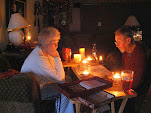
Last year while walking on Ona Beach, J.C. and I found a large glob of Squid eggs that had come loose from their hold fast and washed up on the beach. We collected a few clusters and brought them home. We put some in a small tank at J.C.’s house and I took the rest to work the next morning. Since I was working for the E.P.A at the Marine Science Center, and had access to all of the labs, I borrowed a large aquarium, hooked it up with a steady supply of unfiltered marine water, dropped the eggs in and hoped for the best.
A few days later when I arrived at work, (I was usually the first one in the building in the mornings,) I checked the tank and it was full of tiny, miniature squidlings swimming about, in their squirty, squidy way. Later that day I showed them to the head research oceanographer, and got permission to use one of the cool binocular microscopes located in another lab.
I came to work earlier than usual the next morning, captured some of the babies in a small jar and took them to the microscopy lab. Earlier, one of the scientists had shown me how to use the equipment, and where to find the concave slides I would need to hold the squid in liquid while I viewed them. It only took a few seconds to transfer them to the slide with an eyedropper, and when I peered into the eyepieces, and turned the focus knob a few clicks, I was rewarded with an amazing sight. Instead of little swimming dots I was now looking at squid! I could easily see their huge black eyes and through a transparent body speckled with brown spots I could see the heart beating. Then, amazingly, the spots changed color to yellow, then to orange, then to black and finally back to brown again. Sometimes the spots would get larger and then they would almost disappear. I watched in awe as they squirted around in the little pool of seawater on that slide and for a while completely lost track of time.
I had rigged a brine shrimp hatchery in the lab to feed them, hoping to grow them up to full size, (six to eight inches) but by the next morning they were dying at an alarming rate. I brought my video camera to work and took some fair video through the microscope lens, but they never did the color change again; I think they were lacking some natural food that I couldn’t provide. Later that day I took them out to the bay and poured them down into the water between the rocks. Hopefully a few survived, I guess none of them would have made it if we had left them on the beach.

No comments:
Post a Comment